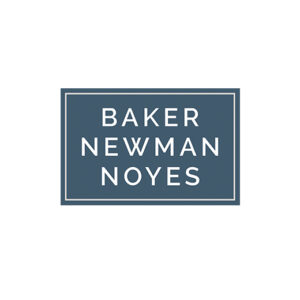Major Provisions of the CMS HHA Final Rule

In an effort to recognize the shifting landscape of healthcare both nationally and here in New England, the Baker Newman Noyes Healthcare Advisory Group has put together a detailed summary explaining key regulatory and operational changes impacting home health care providers as a result of the CMS CY19/20 Final Rule. The following summary will serve to inform providers of operational changes needed as well as prepare them for new reporting requirements to maximize potential reimbursement.
Major provisions of the centers for Medicare and Medicaid services (CMS) home health agency (HHA) and home infusion therapy provider payment systems
1. Home health prospective payment system (HH PPS) updates
- CMS is recalibrating the HH PPS case-mix weights, using the most current cost and utilization data available.
- Finalized rebasing of the home health market basket and updated payment rates under the HH PPS lead to a 2.2% increase in payments.
- Finalizing a reduction in the labor-related share from 78.5% to 76.1% of total costs to account for a rebased home health market basket.
- CY 2019 home health wage index is updated using FY 2015 hospital cost report data.
- Finalizing methodology for applying rural add-on payments for CYs 2019 through 2022.
- Finalizing reductions to the fixed-dollar loss ratio from 0.55 to 0.51 for CY 2019 to increase outlier payments as a percentage of total payments, so that this percentage is closer to, but not more than, 2.5%.
- Finalizing case-mix methodology refinements and a change in payment units from a 60-day episode of care to a 30-day period of care effective January 1, 2020.
2. Home health value based purchasing model (HH VBP)
- CMS is continuing its HH VBP demonstration model in the following nine states:
- Arizona
- Florida
- Iowa
- Maryland
- Massachusetts
- Nebraska
- North Carolina
- Tennessee
- Washington
- Removal of two Outcome and Assessment Information Set (OASIS) based measures: Influenza Immunization Received for Current Flu Season and Pneumococcal.
- Replacement of three OASIS-based measures: Improvement in Ambulation-Locomotion, Improvement in Bed Transferring, and Improvement in Bathing.
- Total Performance Scores (TPS) will be calculated by utilizing the weighting methodology for OASIS-based claims.
- Reduction in the maximum amount of improvement points an HHA can earn, from 10 points to 9 points.
- Maximum payment adjustments, based on an organization’s TPS, through CY2022:
- CY2019: 5%
- CY2020: 6%
- CY2021: 7%
- CY2022: 8%
3. Home health quality reporting program (HH QRP)
- Adopting eight measure removal factors, removing seven measures and finalizing a proposal to increase the number of years of data used to calculate the Medicare Spending per Beneficiary measure from one year to two years.
4. Home infusion therapy
- Added new health and safety requirements for home infusion therapy suppliers.
- Finalized a set of regulations that will govern the CMS approval and oversight process for all home infusion therapy Accrediting Organizations (AO).
Changes regarding certifying and recertifying patient eligibility for Medicare home health services
Amending regulations that will allow HHA medical record documentation to be used to support certification and/or recertification of home health eligibility if requirements are met:
-
- Other medical record entries in the certifying physician’s and/or the acute/post-acute care facility’s record that corroborate the HHA documentation
- Certifying physician signs and dates the HHA documentation demonstrating it was considered when certifying the patient’s eligibility for Medicare home health services.
- The goal is for CMS to be more flexible in allowing HHA-generated documentation to support eligibility for home health services as long as the conditions are met.
Health and safety standard for home infusion therapy
- Newly established requirements:
- Plan of care to be initiated and updated by a physician.
- 24/7 access to services and remote monitoring.
- Patient education and training regarding their home infusion therapy care.
- Current AOs must submit an application to CMS for approval of their home infusion therapy accreditation program, and CMS approved AOs must accredit home infusion suppliers no later than January 1, 2021 in order for the home infusion supplier to receive Medicare payments beginning January 1, 2021.
- Home infusion suppliers must select a CMS-approved AO and undergo an accreditation review process to demonstrate that the home infusion supplier meets the AO’s standards and to meet the definition of a “qualified home infusion therapy supplier”.
- Of note, current and existing home infusion therapy suppliers, having previously been accredited by one of eight home infusion therapy AOs, are deemed to have met accreditation requirements in order to receive payment under the transitional payment program in 2019 and 2020, until the permanent payment program goes into effect January 1, 2021.
Payment for home infusion therapy services
- Temporary transitional payments for home infusion therapy services for CYs 2019 and 2020:
- Home infusion suppliers are defined as suppliers that are enrolled in Medicare as pharmacies that furnish external infusion pumps and external infusion pump supplies, and maintain all pharmacy licensure requirements in their respective state.
- Services must be furnished by an eligible home infusion supplier in an individual’s home, to an individual who is under the care of an applicable provider, and where there is a plan of care established and periodically reviewed by a physician prescribing the type, amount, and duration of infusion therapy services.
- The Healthcare Common Procedure Coding System (HCPCS) codes for the drugs and biologicals covered under the Local Coverage Determinations (LCDs) for External Infusion Pumps are identified in three payment categories for which a single payment amount will be established for the home infusion therapy services furnished on each infusion drug administration day.
- Payment category 1 includes antifungals and antivirals, uninterrupted long-term infusions, pain management, inotropic and chelation drugs.
- Payment category 2 includes subcutaneous immunotherapy infusions.
- Payment category 3 includes certain chemotherapy drugs.
- In the case that two (or more) drugs or biologicals from two different payment categories are administered to an individual on the same day, one payment for the highest payment category would be made.
- New HCPCS G-codes for each of the three payment categories should be included in line item detail on the claim, including a G-code for each infusion drug administration calendar day and length of time for professional services (15 minute increments).
Implementation of the patient-driven groupings model (PDGM)
- CMS is finalizing the implementation of the Patient-Driven Groupings Model (PDGM), which will begin on January 1, 2020. The switch to the PDGM will impact payments received under the HH PPS in a number of ways, most notably by changing the home health case mix weighting system, and by changing the unit of payment from 60-day episodes of care to 30-day periods of care.
- Case mix weights will no longer factor in the number of therapy visits involved in a care period, but rather will be based on diagnosis, functional level, and other characteristics of each patient that influence the plan of care.
- This change increases the number of case mix groupings from 153 to 432, resulting in a greater level of specificity for payment.
- The case mix groupings were determined using a Cost-Per-Minute (CPM) plus Non-Routine Supplies (NRS) approach, which relies more heavily on Medicare cost report data. Payments under the HH PPS relies heavily on information in the OASIS, which is used to determine case mix grouping for payment.
Economic analysis
HH PPS
- CY 2019
- CMS estimates Medicare payments to HHAs will increase by 2.2%, or $420 million, detailed as follows:
- 2.2% home health payment update percentage ($420 million increase);
- 0.1% increase in payments due to decreasing the fixed-dollar-loss (FDL) ratio in order to pay no more than 2.5% of total payments as outlier payments (a $20 million increase); and
- 0.1% decrease in payments due to the new rural add-on policy mandated by the Bipartisan Budget Act of 2018 ($20 million decrease).
- CMS estimates Medicare payments to HHAs will increase by 2.2%, or $420 million, detailed as follows:
- CY 2020
- CMS estimates that the overall Medicare payments to HHAs will remain constant, due to the requirement that PDGM be implemented in a budget-neutral manner.
HH VBP
- CY 2018 through CY 2022:
- CMS estimates that the overall economic impact to Medicare for CY 2018 through CY 2022 will be $378 million in total savings from a reduction in unnecessary hospitalizations and skilled nursing facility usage.
- CMS estimates that there will be no overall payment changes to HHAs competing under this model in the nine demonstration states.
OASIS changes related to HH QRP and HH PPS (PDGM)
- CY 2020
- CMS estimates that, beginning on January 1, 2020, the OASIS methodology changes will result in an annual savings of $60 million to HHAs (from the reduced burden from OASIS item collection).
Home infusion therapy temporary transitional payments
- CY 2019
- Home infusion therapy services are estimated to have a net impact of the temporary transitional payments to eligible home infusion suppliers of $60 million in CY 2019 ($48 million in Medicare payments and $12 million in beneficiary cost sharing).
How we can help
BNN recognizes the unique challenges and opportunities facing home health and infusion therapy providers as healthcare delivery continues to shift to more ambulatory settings. We collaborate with providers to:
- Review historical claims data and project anticipated case-mix adjustments
- Model financial impact of HH PPS adjustments
- Ensure provider systems are prepared for case-mix adjustments to streamline reimbursement
- Provide education to leadership and staff around the rule changes and impact
If you would like to discuss any of these topics further, contact your BNN healthcare advisor at 800.244.7444.
Disclaimer of Liability: This publication is intended to provide general information to our clients and friends. It does not constitute accounting, tax, investment, or legal advice; nor is it intended to convey a thorough treatment of the subject matter.
